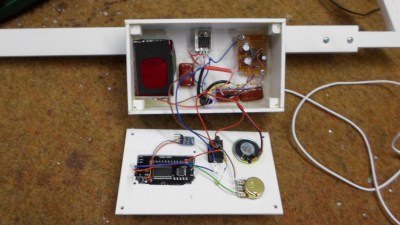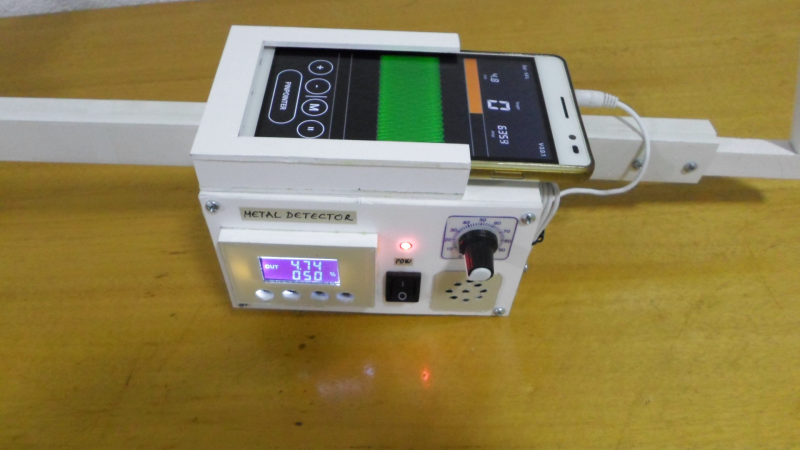If you ever thought about becoming a treasure hunter this simple DIY metal detector by [mircemk] may be a nice project to start with.

The design is based on an opensource metal detector called Smart Hunter. This Very Low Frequency (VLF) metal detector uses transmitter and receiver coils in so-called Double-D geometry. The transmitter coil is driven by a signal generator module that operates at its resonant frequency of 4.74 kHz.
The resulting oscillating magnetic field will induce eddy currents in a nearby metal object that in turn induce a signal in the receiver coil. This signal is then fed into the microphone port of a smartphone and analyzed by a custom metal detector app. [mircemk] also included an audio amplifier and small speaker into the device.
The detector turned out to be quite sensitive and can detect a coin at up to 25 cm distance and larger metal objects even up to 1 m. Modern metal detectors can also distinguish between different types of metal by analyzing the phase shift of the detected signal which might be some way to improve the design.
Video after the break.
















Hmm, my friend up the road, semi retired prospector in Western Australia, has been looking at this sort of paradigm asking me for input, so hey great timing, thanks for post :-) Curious on comments too, cheers
Well, as someone that’s done a little metal detecting/treasure hunting. This think probably will work well enough for some, but wouldn’t get me excited enough to build. There is quite a few things that need to be tuned, to the ground you are searching. There is a lot of junk metal in the ground, that you don’t generally want to listen to, or dig up. Were you generally find coins and other treasures, you find a lot of garbage as well. Target ID isn’t a guaranty, even on expensive units.
Your success and return on your investment, depends on how much time and effort you put into it. Digging holes isn’t quite as easy as you would think. In your own yard, you can pull out the garden spade, and dig all you want, if you don’t care about how torn up you leave it. Out in public, you want to keep it looking clean and neat, so your hobby doesn’t get cut short, because of people complaining about damage you leave behind. Deep holes, with a hand digging tool, is a lot of work. I usually kept to 7-8 inches, not to hard to dig or fill, and not likely to strike buried utilities, or sprinkler lines.
I’m a former detector. There’s one major point left out here: Parks…they may be banned. Our hobby went under fire and archaeologists basically said we are plundering sacred ground when we find artifacts. They worked to get our hobby banned in national parks in the United States, saying we leave holes everywhere and take priceless heirlooms found in the ground. Most of the guys I used to know did it to find old coins, or help folks who lost wedding rings at the beach. You get weird looks and harassment these days, which is why I quit. It was fun, but it ended up being too much heartache.
there are so many hobbies being destroyed because a noisy person gets annoyed and focuses their life on ruining enjoyment for others. I wish the solution was not to just legislate everything into oblivion.
There are so many hobbies being destroyed because a few hobbyists are so unsympathetic that they don’t play well with others and don’t clean up after themselves, and it’s a lot easier to just legislate the whole field into oblivion than try to get rid of the idiots.
There is a big problem with this in Sweden. A lot of ancient artifacts are digged up and sold. I found a neckless sold in USA on the net that was found in Sweden and it was sold illegal, they could not find the private owner so it’s now in a private collection, and that is just so sad, they are supposed to be given to the state and get out to museums. It’s not illegal to search but a person has to get permit.
Hackaday is getting quite an encyclopedia of DIY knowledge. Here are other related projects:
https://hackaday.com/2019/11/26/progressive-or-thrash-how-metal-detectors-discriminate/
https://hackaday.com/2012/02/23/autonomous-metal-detector-lets-you-sit-back-get-rich/
https://hackaday.com/2019/02/26/an-attiny-metal-detector/
https://hackaday.com/2018/07/11/a-graph-plotting-metal-detector/
I duplicated one of the links with one you had in the article. Feel free to delete if you want
can you please tell me which app to use, can you give me the link? thanks
AFAIK treasure hunters use the analog audio feedback to determine, object, material, size etc… Here the digital output don’t give much information, pitty, I was expecting machine learning detection.
The audio you hear from a metal detector is just audio feedback to help you pinpoint an object once you know something is there. It gets higher pitched the closer you zero in. Some detectors simply beep as you swing over metal and the beep tones will change pitch depending on the quality of metal–for instance silver will be high pitched while iron will be low pitched. Audio alone doesn’t give you all the information, that is done with a gauge or digital readout that quantifies the dwell/shift/decay time of the reflection into a number. As you sweep over the object, eddy currents get induced and the pickup hears this and measures this based on known metal types and object sizes. It can also determine distance. Remember though that all the output a metal detector gives is just a guess, and not fact. I have had many hits that tell me silver and turned out to be buried tinfoil. Iron nails would sometimes pop as gold. It’s all very frustrating. You end up cleaning out a lot of trash for that 1% you get something of actual value.
“microphone port of a smartphone”
Yeah, about that…
Why dont use smartphone as generator? There is stereo output, one can be used as generator and second as alarm when metal is detected. You would still need some kind of amplifier to drive the coil properly, but you need that anyway.
Sure it’s nice, but for me it’s dowsing or nothing!
When he said 25cm I thought he was talking about deep not side to side. It is interesting that it does not go off on his floor, assuming the sub floor is nailed down with iron nails.
I live on a farm and I thought a metal detector would be fun. Not. I can not go 6″ without it going off because of something, something being anything from an old washer to a tiny snipped off piece of fence wire.
I had to find one of the property pins which are pretty substantial pieces of iron and we dug a lot of holes before we found them.
I wonder if modern signal processing technology could teach BFO (Beat Frequency Oscillator) metal detectors some new tricks? With the rise of transistor technology and the invention of the VLF-TR (Very Low Frequency – Transmit Receive) metal detector, BFO detector sales steadily dropped through the 1970’s.
Using analog circuitry it was difficult to do tuning, ground balance, and discrimination with BFO. One benefit of BFO was if you wanted to detect deep you simply built a bigger coil, which was a simple thing VS designing a good TR coil. A big BFO coil naturally ignored shallow clutter so they were good for tracing underground metal pipes and wires.
Ok but how can I find a coin 1m deep?? Surely we have great SNR opamps.
What about 10m wide string coil to sweep to ground lot faster?
Also use AI to pattern recognize.
Come on people, hack!
I use my current metal detector to look for soft lead at my black powder shooting range… on a lark I built this one and have to say it does about as well as the under 100 dollar one I got a a big box store…
So worse than the one you already have?
Some of these DIY metal detectors are a nice learning tool or a nice option for those that have a lot of components laying around and time on their hands but not a lot of disposable income to buy one, but the fact is that lately there has been a raising of the bottom end of the detector market such that you can now own amazing machines for as little as a couple hundred dollars. You can own mediocre machines for even less. There’s little to be gained from building your own from a performance standpoint. They lack the depth necessary to find anything truly desirable and cannot compete with machines like the $199 Minelab Vanquish or the $254 Nokta Makro Simplex. Getting the kind of performance these machines offer requires specialized knowledge and top notch tuning components. Metal detecting engineering is one of the most challenging areas of electronics, and extremely talented engineers have had to use a shit ton of cognitive horsepower trying to squeeze ever more depth, speed and target info out of these machines. I have yet to see a DIY unit that would be worth the time to build in modern times. It used to be the case that DIY units could be constructed competitively, but they’ve been left in the dust by recent advances. I hope one day that changes, but for now anyone interested in this would be far better off purchasing a late 90s/early 2000s Whites Classic II- Classic IDX Pro and doing some component mods. These machines can be had dirt cheap and the mods actually do double performance and add usable features.
I’d be interested in hearing about the mods you refer to.
Same here…
How about something like this though?
https://patents.google.com/patent/US7710118B2/en
Same here. I wish OP would updaye
Please do post the mods mentioned, I’d love to get into MD on the cheap
Personally, I’m wondering if a downward-facing camera could be used for positioning to help make a heatmap of the area under the head.
Could someone please list all the components needed for this project? TIA
I’m also interested in knowing more about diy components mods for my old whites detector.
https://metaldetectingforum.com/showthread.php?t=22600
are you Mr. Bill? if so can i ask what model of pots you use? RV6 is the ones I am looking at. figured top shelf or similar pots would be much better to use.